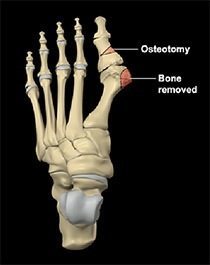Foot Treatments
Bunion Surgery
A bunion, also called a hallux valgus, is an enlargement of bone or soft tissues around the joint at the base of the big toe that results in the formation of a bump. The bone that joins the big toe with the first metatarsal bone thickens and enlarges, tightening the tendons, which in turn causes the base of the big toe to angle out resulting in a painful bony deformity.
Limb Reconstruction
Reconstructive surgery is a procedure wherein injured areas or defects are corrected by using flaps of tissue, skin, boneor metalwork, along with underlying blood vessels or muscle to rebuild the damaged tissues. Reconstructive surgeries on the upper and lowerlimb are performed to improve the structural, functional and cosmetic outcome of injured limbs. The upper limb includes all the structures from the fingertips to the neck along with the nerves that control the arms. The lower limb includes the hip, thigh, leg and foot. Reconstruction of these structures can avoid amputation or shortening of limbs, and prevents many complex defects that result from injuries.
Foot Reconstruction

Foot reconstruction is a surgery performed to correct the structures of the foot and restore the natural functionality of the foot that has been lost due to injury or illness.
Lesser Toe Surgery
Lesser toes, also called as smaller toes are those other than the big toe found in your foot. The lesser toe has three phalanx bones namely distal, middle and proximal and two phalangeal joints namely distal interphalangeal joint (DIPJ) and proximal interphalangeal joint (PIPJ). The common types of deformities that affect the lesser toes are – claw toe, hammer toe and mallet toe.
Foot Arthroscopy
Coming soon
Syndesmosis Surgery without the Tightrope
The ankle is made up of the tibia and fibula bones of the lower leg, and the tarsus bone of the foot. They are held together by ligaments, which provide strength and stability during movement.
Foot Fusion surgery
Coming soon

 Menu
Menu




